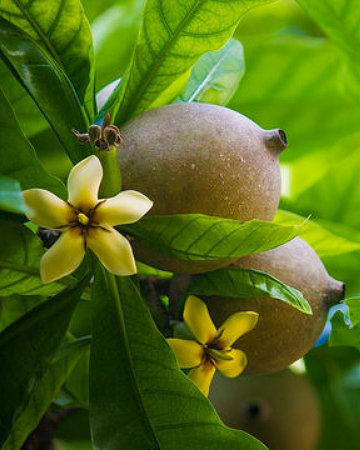
|
|
Marmalade Box
(Genipa americana). Flowers and fruits.
|
Marmalade Box - Genipa americana
Genipa americana is a species of trees in the family Rubiaceae. It is native to the tropical forests of North and South America, as well as the Caribbean.
In English, the tree is known as the genip tree and the fruit as genipap. It has a number of colloquial names: marmalade box in former British West Indies; genipa, jagua or caruto in Puerto Rico and several other Spanish-speaking countries; genipapo or jenipapo in parts of Colombia and Brazil; chipara or chibara or guanapay among Colombian
Indians. A medium-sized, dry deciduous tree with large, oval leaves and rounded, grayish, apple-sized, thick-skinned, edible fruits that can be eaten raw or made into jam, drinks or ice cream. Inspired by its use in South America, a gel made from Genipa americana has recently become popular for temporary tattoos in Europe and North America.
Genipa americana trees are up to 30 m tall and up to 60 cm dbh. The bole is usually
straight. Their bark is smooth with little fissures. The leaves are opposite, obovate, or obovate oblong, 10–35 cm long, 6–13 cm wide, and glossy dark green, with entire margin, acute or acuminate apex, and attenuated base. The inflorescences are cymes up to 10 cm long. The flowers are white to yellowish, slightly fragrant, calyx bell-shaped, corolla at 2–4.5 cm long, trumpet-shaped, and five- or six-lobed. The five short stamens are inserted on top of the corolla tube.
The fruit is a thick-skinned edible greyish berry 10–12 cm long, 5–9 cm in diameter.
The fruit is elliptic or rounded-oval tapering briefly at the stem end, and having a short hollow tube at the apex. It has a thin leathery, yellow-brown, scurfy skin adherent to a 1/4 to 1/2 in (6-12.5 mm) layer of muskily odorous, rubbery, whitish flesh (turning yellowish on exposure). The central cavity is filled with flat, circular, yellowish or brown seeds 3/8 to 1/2 in (1-1.25 cm) long, enclosed in grayish-yellow, mucilaginous membranes arranged in rows around a central fleshy core. The fruit, like the European medlar (Mespilus germanica L.) is edible only when overripe and soft to the touch, when the flavor, acid to subacid, resembles that of dried apples or quinces.
The fruit can be eaten fresh, made into juices,
jelly, or ice cream, or used to make marmalade and
preserves. Its main use is as a popular source of beverages - the pulp from mature fruits is cooked with sugar to produce a syrup used to make various beverages and deserts.
In Puerto Rico, the fruit is cut up and put in a pitcher of water with sugar added to make a summer drink like lemonade. Sometimes it is allowed to ferment slightly. A bottled concentrate is served with shaved ice by street vendors. In the Philippines, also, the fruit is used to make cool drinks, as well as jelly, sherbet and ice cream. The flesh is sometimes added as a substitute for commercial pectin to aid the jelling of low-pectin fruit juices. Rural Brazilians prepare sweet preserves, sirup, a soft drink, genipapada, wine, and a potent liqueur from the fruits.
In Guyana, the ripe fruit is used mainly as fish bait. The fallen, astringent fruits are much eaten by wild and domestic animals.
The juice of the unripe fruit is colorless but oxidizes on exposure to the air and gradually turns light brown, then blue-black, and finally jet black. It has been commonly employed by South American Indians to paint their faces and bodies for adornment and to repel insects; and to dye clothing, hammocks, utensils and basket materials a bluish-purple. Most tribes like the Emberá Wounaán, a native tribe in Panama, use fresh Jagua as a corporal painting, for ceremonial purposes and because it repels insects. The Matsés Indians of Peru also insert it underneath the skin to create permanent tattoos. The dye is indelible on the skin for 15 to 20 days.
Some Guatamalan tribes arry the fruits in their hands in the belief that this will provide protection from disease and ill-fortune.
The fruit is eaten as a remedy for jaundice in El Salvador. Ingested in quantity, it is said to act as a vermifuge. The fruit juice is given as a diuretic. It is a common practice in Puerto Rico to cut up the fruits, steep them in water until there is a little fermentation, then add flavoring and drink the infusion as a cold remedy.
Because the fruit and its infusion have unusually good keeping quality, Puerto Rican scientists investigated the possible presence of antibiotic principles and proved the existence of antibiotic activity in all parts of the fruit.
The crushed green fruit and the bark decoction are applied on venereal sores and pharyngitis. The root decoction is a strong purgative.
The bark exudes when cut a whitish, sweetish gum which is diluted and used as an eyewash and is claimed to alleviate corneal opacities. The juice expressed from the leaves is commonly given as a febrifuge in Central America. The pulverized seeds are emetic and caustic. The flower decoction is taken as a tonic and febrifuge.
The bark, rich in tannin, has been used for treating leather. It also yields a fiber employed in making rough clothing.
The wood is reported to be resistant, strong, and easily worked; it is used in the making of utensils and in construction and carpentry.
Source:
https://en.wikipedia.org/wiki/Genipa_americana
https://hort.purdue.edu/newcrop/morton/genipap.html
https://www.suzannedekel.com/nl/post/
genipa-americana-the-mystical-blue-jagua-from-south-america-2
